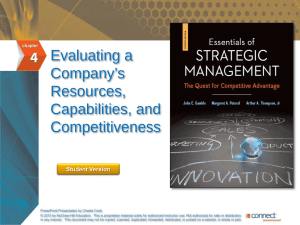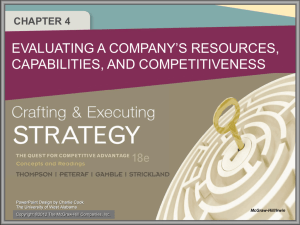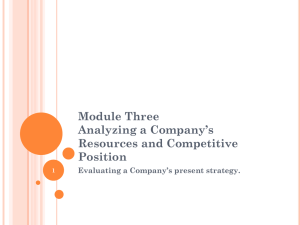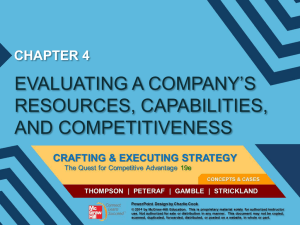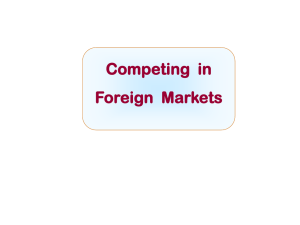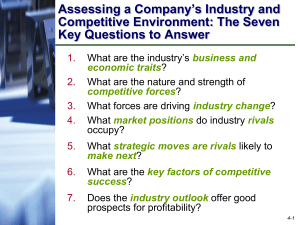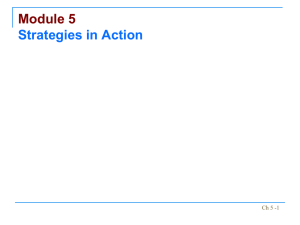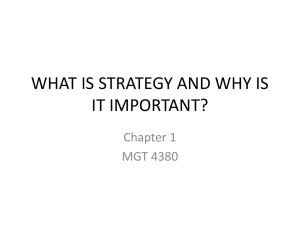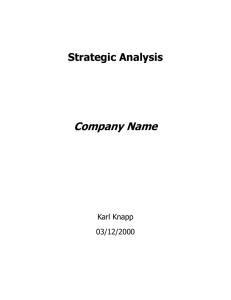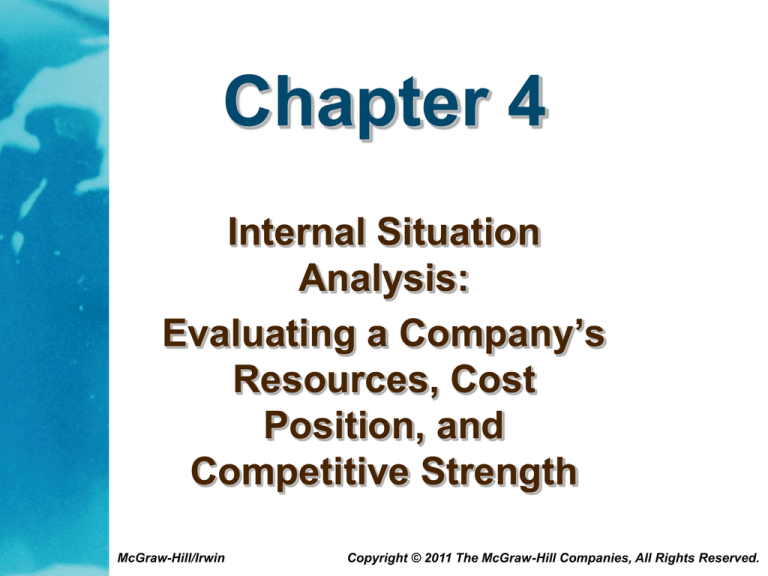
Chapter 4
Internal Situation
Analysis:
Evaluating a Company’s
Resources, Cost
Position, and
Competitive Strength
McGraw-Hill/Irwin
Copyright © 2011 The McGraw-Hill Companies, All Rights Reserved.
Key Questions in Situation Analysis
Question 1: How well is the company’s
strategy working?
Question 2: What are the company’s
competitively important resources and
capabilities?
Question 3: Are the company’s prices and
costs competitive?
Question 4: Is the company competitively
stronger or weaker than key rivals?
Question 5: What strategic issues and
problems merit front-burner managerial
attention?
4-2
Situation Analysis Question 1: How
Well is the Company’s Strategy
Working?
1. Is the company achieving its
financial and strategic objectives?
2. Is the company an above-average
industry performer?
4-3
Performance Indicators
Trends in sales and earnings growth
Trends in the company’s stock price
The company’s overall financial strength
The rate at which new customers are acquired
Image and reputation with customers
Evidence of improvement in internal processes
such as defect rate, order fulfillment, and days
of inventory
4-4
Situation Analysis Question 2: The
Company’s Competitively Important
Resources and Capabilities
A company’s strategy and business
model
Must be well-matched to its collection
of resources and capabilities
Is strengthened when exploiting
resources that are competitively
valuable, rare, hard to copy, and not
easily trumped to rivals’ equivalent
substitute resources
4-5
Resource-Based Strategies
Resource-based
strategies attempt to
exploit a company’s
valuable and rare
resources and
competitive capabilities
to deliver value to
customers in ways
rivals find it difficult to
match
4-6
Identifying Competitively Important
Resources and Capabilities
Common types of valuable resources
and competitive capabilities include
Skills or specialized expertise in a
competitively important capability
Valuable physical assets
Valuable human assets or intellectual capital
Valuable organizational assets
Valuable intangible assets
Competitively valuable alliances or
cooperative ventures
4-7
Determining the Competitive
Power of a Company Resource
Is the resource really competitively
valuable?
Is the resource rare and something
rivals lack?
Is the resource hard to copy or imitate?
Can the resource be trumped by the
substitute resource strengths and
competitive capabilities of rivals?
4-8
Strategies for Addressing Resource
Deficiencies
Companies lacking a competitively
powerful stand-alone resource may
be able to support its strategy with a
bundle of resources.
Companies may be able to
neutralize the power of rivals’
resources and capabilities by
developing substitute resources
to accomplish the same purpose.
4-9
Resources and Capabilities as the
Foundation of Competitive
Advantage
A competence represents real
proficiency in performing an internal
activity
A core competence is a well-performed
internal activity central to a company’s
competitiveness and profitability
A distinctive competence is a
competitively valuable activity a
company performs better than its
rivals
4-10
Taking Inventory of a Company’s
Strengths, Weaknesses,
Opportunities and Threats
S W O T represents the first letter in
S trengths
W eaknesses
O pportunities
T hreats
For a company’s strategy to be wellconceived, it must be
Matched to its resource strengths and
weaknesses
Aimed at capturing its best market opportunities
and defending against external threats to its wellbeing
4-11
Identifying Resource Weaknesses
and Competitive Deficiencies
A weakness is something a firm lacks,
does poorly, or a condition placing it at a
disadvantage in the marketplace
Resource weaknesses relate to
Inferior or unproven skills,
expertise, or intellectual capital
Deficiencies in competitively important
physical, organizational, or intangible assets
Missing or competitive inferior capabilities in
key areas
4-12
Identifying a Company’s
Market Opportunities
Opportunities most relevant to
a company are those offering
Good match with its
financial and
organizational resource
capabilities
Best prospects for growth
and profitability
Most potential for
competitive advantage
4-13
Identifying External Threats to
Profitability and Competitiveness
Entry of lower-cost foreign competitors
Burdensome regulations
Rise in interest rates
Potential of a hostile takeover
Unfavorable demographic shifts
Adverse shifts in foreign exchange rates
4-14
Overall Value of a SWOT Analysis
Ability to draw conclusions about the
company’s overall situation.
Ability to translate into strategic actions:
Better match the company’s strategy to its
resource strengths and market opportunities,
Correcting problematic weaknesses, and
Defending against worrisome external
threats.
4-15
Situation Analysis Question 3: How
Competitive Are the Company’s
Prices and Costs?
Assessing whether a firm’s costs are
competitive with those of rivals is a
crucial part of company situation analysis
Key analytical tools
Value chain analysis
Benchmarking
4-16
Company Value Chain
4-17
Benchmarking Costs of
Key Value Chain Activities
Focuses on cross-company
comparisons of how certain activities
are performed and costs associated with
these activities
Purchase of materials
Payment of suppliers
Getting new products to market
Performance of quality control
Filling and shipping of customer orders
4-18
Industry Value Chain
4-19
Strategic Options for Remedying a
Cost Disadvantage
There are three main areas of a
company’s overall value chain where
cost differences occur
1. Activities performed by
suppliers
2. A company’s own internal
activities
3. Activities performed by
forward channel allies
4-20
Correcting Internal Cost
Disadvantages
Implement best practices throughout
the company
Try to eliminate some cost-producing
activities altogether by revamping value
chain
Relocate high-cost activities to lowercost geographic areas
See if high-cost activities can be
outsourced
4-21
Correcting Internal Cost
Disadvantages
Invest in productivity enhancing, costsaving technology
Find ways to detour around activities or
items where costs are high
Redesign the product or its
components to reduce manufacturing
costs
Make up difference by achieving
savings in backward or forward
portions of value chain system
4-22
Correcting Supplier-Related Cost
Disadvantages
Pressure suppliers for lower prices
Switch to lower-priced substitutes
Collaborate closely with suppliers to
identify mutual
cost-saving opportunities
Integrate backward
into business of
high-cost suppliers
4-23
Correcting Cost Disadvantages
Associated With Forward Channel
Allies
Pressure dealer-distributors to reduce
their costs
Work closely with forward channel
allies to identify win-win opportunities to
reduce costs
Change to a more economical
distribution strategy
Switch to cheaper distribution channels
Integrate forward into company-owned retail
outlets
4-24
Situation Analysis Question 4: What
Is the Company’s Competitive
Strength?
Overall competitive position involve
answering two questions
How does a company rank relative
to competitors on each industry key
success factor?
Does a company have a net
competitive advantage or disadvantage
vis-à-vis major competitors?
4-25
Competitive Strength Assessments
4-26
Interpreting the Competitive
Strength Assessments
Shows how firm stacks up against rivals,
measure-by-measure
Indicates whether firm is at a
competitive advantage or
disadvantage against each rival
Identifies possible offensive strategies
that can be waged against rivals’
weaknesses
Identifies the need for defensive
actions to correct competitive
weaknesses
4-27
Situation Analysis Question 5: What
Strategic Issues Must be Addressed
by Management?
Final and most
important analytical step
in assessing
“Where are we now?”
Based on results of both industry and
competitive analysis
Pinpointing the precise things that should
be on management’s “worry list”?
4-28

